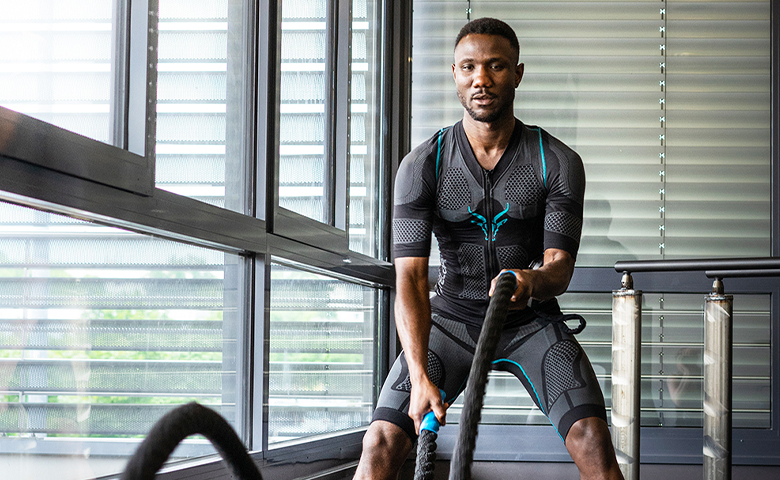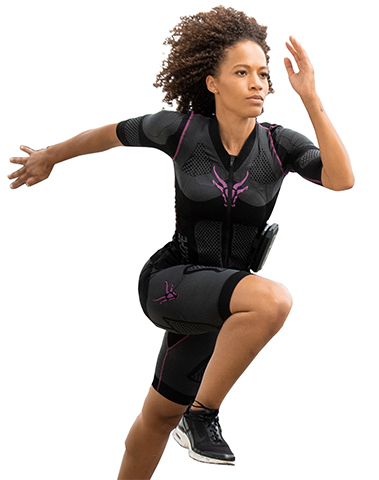Fitness and Health
Clothing That Thinks for You
Staying Fit and Healthy
Fitness trackers and smart fabrics measure your heartbeat, or send electrical impulses to help build muscle. Our high-tech silicones make sure there is an ideal connection between your skin and the sensors.
Ideally, whenever human meets wearable technology, there is always a piece of fabric in between. Smart textile fabrics are used in medicine and in sports. They can measure heartbeat with sensors, or send electrical impulses to help build muscle. To make the ideal connection, a textile pioneer from southwestern Germany uses high-tech silicones from WACKER in its intelligent fabrics. WACKER developed the first silicone products for the textiles and leather sectors 50 years ago.
In more normal times, sports multinationals and textile companies the world over would make their way to Hans Bauer’s showroom to develop new items of clothing with the textile specialist. Now he sits there all alone, surrounded by mannequins dressed in futuristic sports clothing, demonstrating his samples and prototypes in videoconferences. He says that it’s business as usual. And his business – innovative clothing – is booming.
“We were the first to make the electronics and silicones part of the fabric.”
Hans R. Bauer, Founder and Managing Director of NTT
Bauer holds up a sports bra from a well-known sporting-goods manufacturer. “We were the first in the world to integrate a heartbeat monitor in 2004,” he relates. For the interface between the electronics and the body, he used liquid silicones that conduct electricity. “We were the first to make the electronics and silicones part of the fabric,” the inventor explains. Silicones protect the electrodes from abrasion and when the fabric is washed; they are also extremely elastic, skin-compatible and easy to process.
The industry was ecstatic. The word was out: smart fabrics would revolutionize the fitness market. But then, for a long time, nothing happened. Many sports manufacturers who jumped on the bandwagon ended up disappointed. Hans Bauer took it all in his stride. He had already learned that the initial hype elicited by an innovation was often followed by a phase of disillusionment. Now, he says, smart fabrics have reached a point where their advantages truly come to the fore.

Training with electrostimulation: electrodes integrated in a skintight body suit and coated with conductive silicone promote muscle growth.
Ideas for Occupational Safety
For several years now, the textile expert has been fielding inquiries mainly relating to workplace safety – but he’s also received some from the military. Custom undershirts for power electricians can detect when the worker falls and sound the alarm. In South America, sensors in the clothing worn by mineworkers can detect when blood-oxygen levels are too low. Soldiers wear integrated sensors that can detect and report critical injuries. These are just a few examples of clothing that can save lives. Bauer is convinced that “there will be many more meaningful applications in this area.”
Exercise That Doesn’t Stress Your Joints
Functioning business models have also emerged in the fitness sector. One of these is the booming electrical muscle stimulation (EMS) market. Athletes wear skintight body suits equipped with electrodes that stimulate muscle growth. The suppliers of these suits promise effective muscle buildup in as little as 20 minutes of EMS training per week. Because it doesn’t stress the joints, EMS is a good alternative to the bench press, especially for old, frail and overweight persons. Hans Bauer is currently working with several manufacturers on novel EMS suits in which the electrodes are coated entirely with WACKER’S specialty conductive silicones. Perspiration under the silicone rubber connects electrodes to the skin so well that they no longer need to be moistened beforehand – something wearers appreciate a lot.

Training with electrostimulation: electrodes integrated in a skintight body suit and coated with conductive silicone promote muscle growth.

Polyamide-reinforced silicone makes sports textiles more comfortable to wear. Silicone can be used to integrate sensors, too.
Helping Senior Citizens to Live Independently at Home
Analysts believe that the elderly and the infirm will become a major market for smart fabrics. For example, wearing clothing that can monitor vital functions can help senior citizens live independently in their own homes for longer. Electrode suits can enable people suffering from spastic paralysis to walk again unaided. With his company, Hans Bauer is participating in these developments, and here, too, he relies on products and support from Burghausen: “WACKER is just exceptionally innovative in this field, with a giant range of silicones to choose from – and working with the technical service managers in the lab is simply a pleasure.”